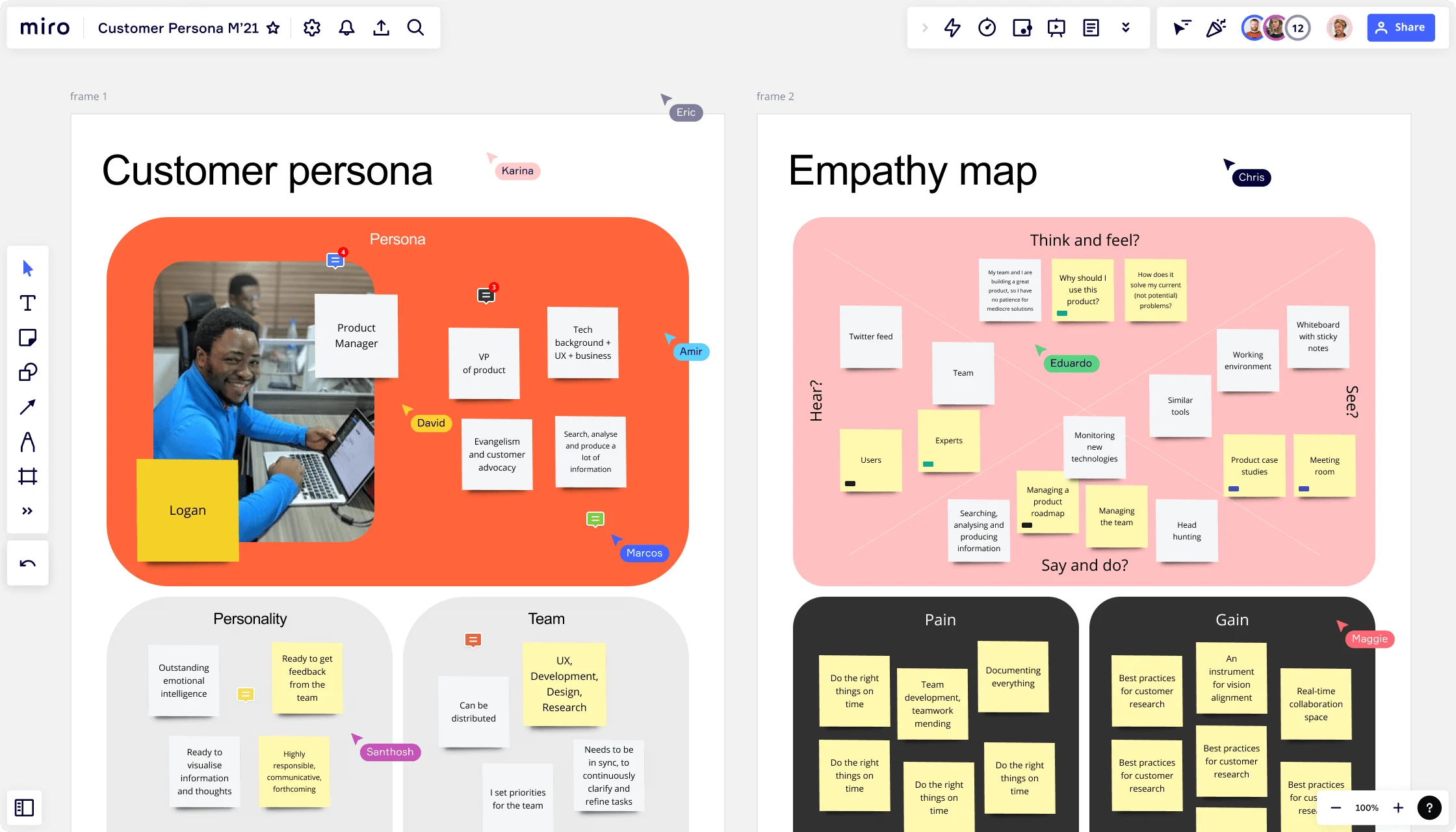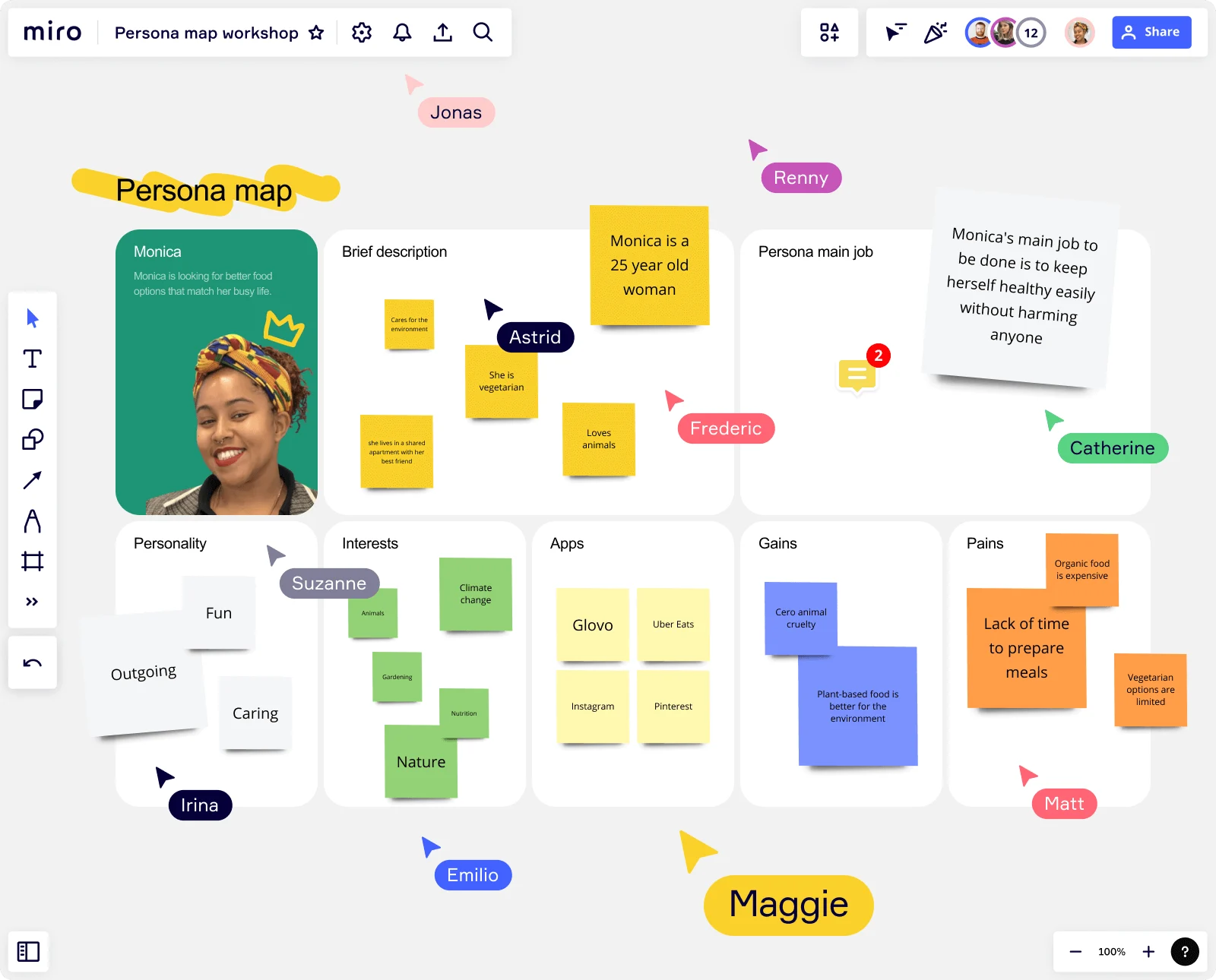
Table of contents
Table of contents
What is a user persona?

Summary
In this guide, you will learn:
What a user persona is: a dynamic, narrative-driven representation of an ideal user.
Common pitfalls in persona creation: making generic profiles lacking depth.
How Miro’s persona creator helps teams: collaboratively build, visualize, and iterate on detailed user personas.
The importance of storytelling in personas: to capture user motivations and contexts.
Steps to create user personas using templates: defining purpose, describing user actions and pain points, and reflecting on findings.
How interactive features in Miro enable: sharing, feedback, and presentation of personas to stakeholders.
Try Miro now
Join thousands of teams using Miro to do their best work yet.
A quick guide to user personas (and why they are important)
User personas are an essential tool for user-centric design, as they provide a detailed and realistic representation of the target audience by using actual data and insights. These personas help designers understand the users' needs, behaviors, and pain points, which is crucial for creating products that resonate on a personal level. This understanding makes the abstract tangible and ensures that every design decision is grounded in real, human needs.
Here are a few reasons why a user persona is so important:
Empathy at the core: The essence of user personas is empathy. By understanding the human behind the screen, we design with a purpose, making products that truly resonate.
Guiding design decisions: With a clear picture of our users, every design choice, from navigation to aesthetics, is made with intention, enhancing usability and user satisfaction.
Fostering collaboration: User personas unify teams under a shared understanding of who they're designing for, breaking down silos and aligning goals.
What is a user persona?
A user persona is more than just a basic user biography. It is a dynamic representation of an ideal user, including narratives about their goals, frustrations, and daily digital interactions. The main objective is to create a vivid image of the user that applies to your product or service.
When creating a user persona, you should:
Prioritize narrative over numbers: While demographics have their place, the power of a persona lies in the story—goals, frustrations, hobbies, and the digital environments they inhabit.
It is important to avoid falling into the persona pitfall. One common mistake is creating personas that are too generic and resemble a checklist rather than a character. Such personas are shallow stereotypes lacking the depth and nuance needed to represent a user segment.
Remember that a good persona is never a one-size-fits-all solution; it should be a bespoke creation tailored to represent the user segment it is designed to represent.
Avoid the trap of creating faceless, generic profiles that fail to provide meaningful insights.
When creating a user persona, you should:
Avoid stereotypes: Generic profiles can lead to misguided assumptions. Ensure your personas are rich with specific, actionable insights.
Add not just any data: The data fueling your personas should be relevant and specific to your product, not just any statistics you come across.
User demographics: Go beyond and gain insights
As times are changing, it is becoming clear that our understanding and approach to user personas must also change. If we rely solely on demographics such as age, gender, and location, we may make assumptions rather than gain insights. Today's personas should be based on psychographics and behavior patterns, focusing on what users do and why they do it and going beyond traditional demographic boundaries.
The shift from demographics to psychographics and behavior patterns marks a move towards a more nuanced understanding of users.
Beyond the basics: Focusing on behaviors and motivations offers a deeper understanding than surface-level demographics alone.
Diversity and inclusion: This approach acknowledges your user base's diverse and complex nature, avoiding oversimplification.

How to build a good user persona
A successful user persona is a combination of both science and art, created with attention and insight. Here's what sets the excellent ones apart from the mediocre:
Make them unique
Each persona should be a distinct entity, representing a specific segment of your audience. No two personas should feel interchangeable; each has goals, challenges, and traits.
Use real data
Authenticity is key. Your personas should be built on a foundation of real-world data and observations, from interviews, surveys, to usage data. This ensures they truly reflect your users.
User personas exist in the present
While projections and future goals are important, a user persona should be firmly rooted in the now. It reflects your audience's current behaviors, needs, and pain points, making it directly actionable.
Be context-specific
Context is everything. A persona for a mobile app will differ significantly from one for a B2B service. Ensure your personas are tailored to the specific context of your project for maximum relevance.
Avoid biases
Our subconscious biases can sneak into persona creation, skewing them away from reality. Challenge assumptions and lean on data to keep your personas true to life.
Key components of an effective user persona
Goals and motivations
What drives your user? What are they trying to achieve with your product?
Frustrations and pain points
Identify obstacles that stand in the way of their goals.
Behavioral patterns
How do they interact with your product and others in their digital ecosystem?
Psychographics
What are their attitudes, interests, and values?
Scenario-based needs
In what context will they use your product, and how does it fit into their daily life? To organize and visualize the components that make up a well-crafted persona, use Miro’s user persona template to guide you.
The importance of user personas when designing products people love
Personas are not just theoretical exercises; they're practical tools that drive design decisions. Here’s how they come into play:
1. Making product decisions
They act as a North Star, guiding feature development, prioritization, and design choices, ensuring the product serves the users it's meant for.
2. Understanding and empathizing with users
Personas bridge the empathy gap, allowing design teams to step into their users' shoes and view the world from their perspective.
3. Aligning teams
In the collaborative effort of bringing a product to life, personas ensure everyone, from designers to marketers, is on the same page about who they’re serving.
Now what? Final tips and what to consider for your user persona
Crafting and utilizing user personas is a journey, not a one-time task. As your product evolves and new insights emerge, your personas should too. They are living documents that breathe life into the design process, guiding your team toward creating user-centric solutions that resonate deeply with your audience. Here’s how you can make the most out of your user personas:
Evolve with your users
Stay attuned to your users' changing needs, behaviors, and environments. Regularly update your personas with fresh insights to keep them relevant and insightful.
Accessibility and visibility
Make sure your personas are not just created but are actively used and referenced. They should be easily accessible to everyone on the team. Here’s where Miro becomes your ally in collaboration and creativity. Use Miro to create, share, and iterate on your personas in real time, ensuring that every team member, regardless of their role or location, has a clear understanding of who you’re designing for.
Integration in design process
Incorporate your personas at every stage of the design process. From brainstorming sessions to user experience mapping, let them guide your decisions and foster empathy. Use your collaborative boards to offer a dynamic space where personas can live alongside your project workflows, sketches, and prototypes, making it easier to align every design decision with the needs and goals of your users.
Collaboration is key
Facilitate workshops and collaborative sessions around your personas. Engage your team in persona-based exercises that deepen understanding and spark innovative solutions. Miro’s interactive tools and templates make these sessions engaging and productive, fostering a shared vision and empathy across your team.
Remember, the ultimate aim of utilizing user personas is to enrich the lives of those who interact with your product. By keeping your personas updated, accessible, and central to your design process, you ensure that every feature, every line of code, and every design element serves a purpose that is meaningful to your users.
Use Miro to build a user persona
Let Miro be your platform for bringing your team together to craft, visualize, and innovate with user personas at the heart of your design journey. Happy designing, and may your user personas be the compass that guides you to create truly impactful and user-centered designs.
Author: Miro Team
Last update: October 14, 2025